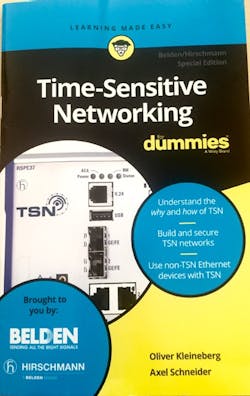Time Sensitive Networking for Dummies
If your work with automation has anything to do with the networks that connect your production operations’ devices and systems, odds are good that you’ve heard about Time-Sensitive Networking (TSN) by now. But with TSN-enabled devices just recently becoming available, the odds are also good that you’re not yet an expert on TSN or its application.
With so much information on TSN available, it can be difficult to know where to start. But if you're looking to begin with a good grounding in the basics, a solid option is the new “Time Sensitive Networking for Dummies” book from Belden/Hirschmann. Published in the well-known “… for Dummies” style, this book is a short (43 pages), easy read. I say “easy” because it avoids getting too far down into the technical weeds, but it doesn’t scrimp on the details either.
It also assumes you have a basic understanding of networking, i.e., how switched Ethernet networks function. If you’re not up to speed on that yet, the book offers suggestions for further reading.
An important point about TSN raised early in the book by its authors, Oliver Kleineberg and Axel Schneider of Hirschmann (a Belden brand supplier of industrial networking technology), is the shifting structure of industrial automation networks in light of the move towards greater digitalization and the Industrial Internet of Things/Industry 4.0. This shift I’m referring to is a move from the well-known automation pyramid structure to an automation pillar structure. (You can read more about this in an interview I conducted with Kleineberg at the 2017 IoT Solutions World Congress.)
The core idea behind this shift is that, in the automation pillar structure, the controller level of the automation pyramid disappears—with some control functions moving to the field as distributed control units (for fast, reliable reactions in applications such as safety), while others move to the management level as centralized control units. These central control units are virtual programmable logic controllers (PLCs) hosted in a local automation cloud where they interact directly with production processes through the connectivity layer that, with the help of TSN, provides high-speed, low latency performance while also carrying background traffic in a way that will not impact time-critical traffic.
Beyond its explanation of the evolving industrial network structure and more specific aspects of TSN, the book covers a number of issues. Some of the more prominent topics addressed include device buying tips, how faults are handled with TSN, the flexibility of TSN network architectures, and security.
When purchasing TSN-enabled devices, the book advises buyers to look carefully at the device’s quality of time synchronization. The tighter the synchronization the better, as lower quality synchronization will require network designs that leave large margins for error and therefore reduce TSN performance.
The authors point out that this is particularly critical in switches and end devices because an extra emergency lane does not exist with Ethernet—there’s just the one cable that all data traffic flows through. As a result, the different priorities of traffic on the network must be able to access the cable at different times so that “time critical traffic experiences a completely empty Ethernet cable at the exact time it is sent.” Here’s how the book describes this happening: The switches open the transmission gates for the high-priority frames all at the same time to ensure that the high priority traffic is uninterrupted along the way. At the same time, the end devices need to know when the transmission gates are opening in the switches so they can time the transmission of high-priority frames accordingly.
As for how TSN handles faults, the authors point out that seamless redundancy maintains continuous operation on a TSN network in the event of a fault, such as with functional safety requirements. According to the book, TSN can use High-Availability Seamless Redundancy (HSR), Parallel Redundancy Protocol (PRP), or IEEE 802.1CB-2017 (part of the TSN standard that operates similarly to HSR and PRP) to provide proper handling of faults. Using any of the methods, “whenever a mission-critical frame is sent, it’s duplicated and routed over at least two redundant paths. When the duplicate frames arrive at their destination, one is accepted and the other is dropped,” say the authors.
Realizing that networking needs will likely change over time, the authors explain why, with TSN, it is not required to definitively settle on a centralized or decentralized architecture from the beginning. You can combine the models. For example, centralized TSN may work well on one part of your network, while decentralized TSN may work better on another. These two models of TSN can be combined as needed within your network. Another option is to create a hybrid model by combining parts of the centralized and decentralized models. In this hybrid mode, the end devices only need to support one configuration protocol. An extra benefit of the hybrid mode is that the user will still have a centralized view of the overall network.
Like anything dealing with Ethernet, cybersecurity is a big concern of users looking into TSN. The book notes that cybersecurity mechanisms are not included in TSN because security is “outside the scope of basic Ethernet.” The authors add that the time synchronization aspects of TSN present a new attack surface that was not present before with basic Ethernet. In addition, a concern with resolving TSN cybersecurity issues is that many network security mechanisms can introduce additional latency and jitter into the network, which can be unacceptable for TSN. Despite there being no quick and easy fix to TSN cybersecurity, there are methods available to deal with these issues. The two methods detailed in the book are segmenting traffic with zones and conduits, and filtering and policing traffic by stream.
If you’re looking to learn more about the basics of TSN, the book can be downloaded for free at: www.belden.com/resources/knowledge/ebooks/time-sensitive-networking-for-dummies-lp

